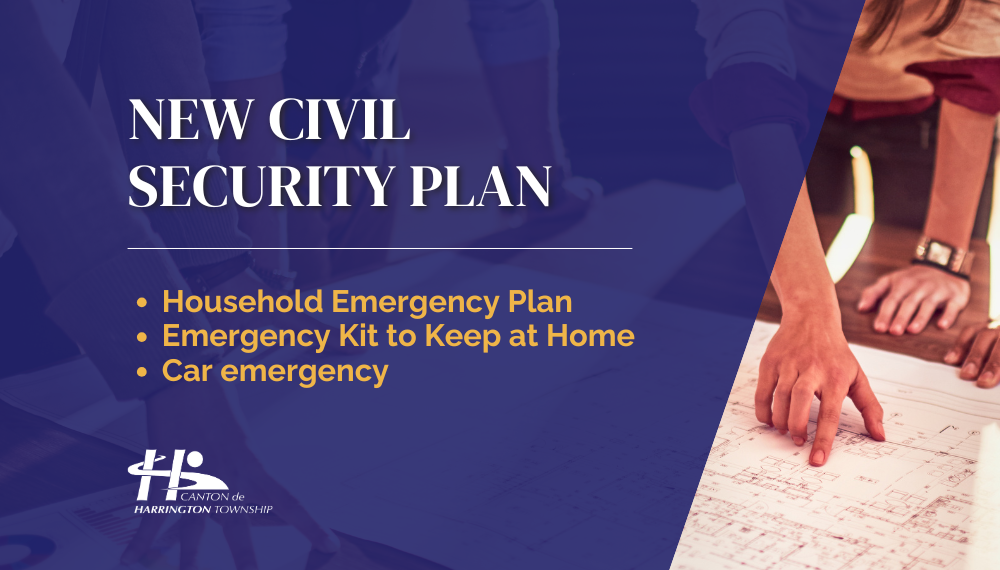During the July 2025 session, the council adopted a new civil security plan.
This document, intended for internal use, allows for the identification of potential risks to which the municipality is exposed, as well as their level of risk, vulnerable populations, measures to be implemented according to different situations, additional resources, modalities for cooperation with various organizations and the various coordinators and responsible parties along with their responsibilities for each mission. The plan aims to enable the municipality to respond effectively and promptly in emergency situations.
You also have a role to play
In the event of an emergency or a natural disaster, first responders may not arrive in your area immediately. You are therefore primarily responsible for your safety. The best way to prepare for such an eventuality is to have a household emergency plan, prepare an emergency kit to keep at home and prepare an emergency kit to kkep in your vehicle.
Make a Household Emergency Plan
- Always have an emergency kit on hand that contains the essential items needed to meet the basic needs of household members for 3 days.
- Draw up a list of the names and contact information of the persons you will need to reach in the event of an emergency (family members, daycare, school, municipality, etc.).
- Prepare a household evacuation plan, determine where family members are to gather and conduct evacuation drills.
- Learn how to turn off the water, electricity and gas (if applicable).
- Determine the route you will take to leave the neighborhood in the event of an evacuation. Determine an alternative route in the event that certain roads are impassable.
- Make an inventory of your property, and include proofs of purchase, photos or video. Store these documents with copies of your home and automobile insurance policies in a safe place outside your home (such as your workplace, for example).
- Contact your insurer to verify your home insurance coverage. The majority of home insurance policies cover damages caused by natural phenomena such as hail, lightning, wind storms or tornadoes.
Prepare an Emergency Kit to Keep at Home
At home, always have on hand an emergency kit (stored in a backpack or bin) containing the items that household members will need to make it through the first 3 days of an emergency situation. Your emergency kit should be stored in an easily accessible location. Verify its contents annually and replace the batteries and bottled water as needed, as well as non-perishable food that has expired.
Below are the 7 essential items you should have in your emergency kit :
- Drinking water (6 litres per person);
- Non-perishable food (for at least 3 days);
- Hand can opener;
- Battery-operated radio and replacement batteries;
- Headlamp or flashlight and replacement batteries or a wind-up flashlight;
- Lighter or matches and candles;
- First aid kit containing antiseptics, analgesics, adhesive bandages, sterile gauze pads, scissors, etc.;
Prepare an Emergency Kit to Keep in Your Vehicle
Keep an emergency kit in your vehicle in the event of a breakdown, an accident or as a precaution during the winter season.
If you become trapped in your vehicle :
- Call 911;
- Stay calm and remain in your vehicle;
- Turn on your vehicle’s hazard lights;
- Limit the use of your vehicle’s battery by alternating between using the lights, heater and radio;
- If it is dark out, turn on the vehicle’s cabin light in order to be visible to first responders;
- Move your limbs to stimulate blood circulation and avoid falling asleep;
- Be alert to symptoms of hypothermia.
If you must turn on the vehicle’s engine to keep the cabin warm, follow the rules below to prevent carbon monoxide poisoning :
- Make sure that nothing is blocking the vehicle’s exhaust pipe (snow, etc.);
- Crack the window on the side opposite to the wind before starting the engine;
- Allow the engine to run about 10 minutes every 30 minutes.
Before leaving, verify road conditions on the Québec 511 website or by calling 511.
If road conditions are difficult, leave only if it is absolutely necessary.
Source: GOUVERNEMENT DU QUÉBEC. Prepare an Emergency Kit and an Household Evacuation Plan, [Online], updated February 6, 2025. [https://www.quebec.ca/en/public-safety-emergencies/emergency-situations-disasters-and-natural-hazards/how-prepare-at-home] (Accessed August 6, 2025)

